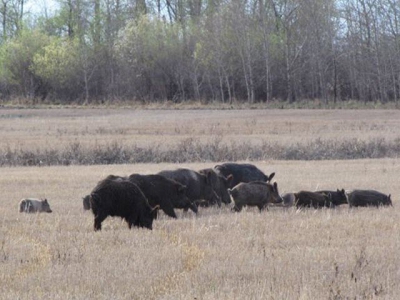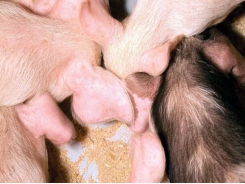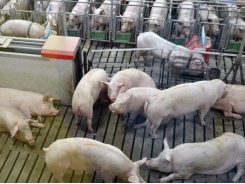Wild pigs expand range in Canada

Expanding range of wild pigs across Canada is emerging crisis for agriculture and environment.
A sounder of wild pigs. Mature females and their litters of various ages, in Saskatchewan, Canada feeding on harvested crop residue. The hybrid wild pigs have lighter colored hair than true Eurasian wild boar.
Wild pigs — a mix of wild boar and domesticated swine — are spreading rapidly across Canada, threatening native species such as nesting birds, deer, agricultural crops and farm livestock, according to research by the University of Saskatchewan (USask).
USask said the first-ever published survey of the wild pig distribution in Canada has found a rapid expansion in the invasive species' range, which is increasing by 9% each year.
"Wild pigs are ecological train wrecks. They are prolific breeders, making them an extremely successful invasive species," said Ruth Aschim, a doctoral student at USask who led the research published in Nature Scientific Reports. "Wild pigs can cause soil erosion, degrade water quality, destroy crops and prey on small mammals, amphibians and birds."
Furthermore, a brochure from the U.S. Department of Agriculture notes that wild pigs can carry many livestock diseases, including swine brucellosis, tuberculosis, porcine circovirus type 2, porcine epidemic diarrhea virus, porcine reproductive and respiratory syndrome virus, Escherichia coli and trichinella, among others. Additionally, in Europe, wild boar have spread African swine fever.
Wild boars were brought from Europe in the late 1980s and early 1990s to diversify Canadian livestock production, USask said, and others were imported as "penned game" for shooting.
The hybrid wild pigs have rapidly multiplied and spread, making them the most prolific invasive mammal in Canada.
By 2017, they had spread exponentially across Canada, from British Columbia to Ontario and Quebec, with the majority found in the south-central half of Saskatchewan. Their territory has increased by 88,000 sq. km per year, on average, over the last decade.
Concentrated on the Canadian prairies, wild pigs currently have a range of more than 750,000 sq. km, the USask research found.
The researchers determined that the territory of a male wild pig can be as large as 300 sq. km in the summer, with sows covering up to 230 km.
The research team, based in USask's animal and poultry science department in the College of Agriculture & Bioresources, has mapped the pigs' range as it has expanded since their initial introduction onto the landscape in the early 1990s.
These maps, published alongside the USask research, show that wild pigs are now firmly established in Saskatchewan, Alberta and Manitoba, with populations scattered in British Columbia, Ontario and Quebec.
Newfoundland & Labrador, New Brunswick, Prince Edward Island, Nova Scotia, the North West Territories, the Yukon and Nunavut do not currently host wild pig populations. A group of escaped wild pigs in the Yukon were removed last summer, USask said.
Wild pigs also cover a large territory in the U.S., based on USDA distribution mapping.
Wild pigs typically weigh between 120 and 250 lb., the researchers said, noting that sows have around six piglets per litter per year.
They are adapted to very cold temperatures and can breed in any season, living in "pigloos" burrowed into the snow. These pigs are sexually mature within four to eight months and feed on common farm crops, including corn, wheat and canola. They also eat insects, birds, reptiles and small mammals.
"The growing wild pig population is not an ecological disaster waiting to happen; it is already happening," said USask's Ryan Brook, lead researcher for the Canadian Wild Pig Project and Aschim's supervisor. "Wild pigs are so widespread that they are a major challenge to control in Canada, and eradication is only possible with a comprehensive plan to deal with this highly efficient invasive species. In Saskatchewan, they are already posing significant risks to agriculture and livestock production. Our mapping of their expanding territory shows just how quickly they are spreading. This is a rapidly emerging crisis."
The research team surveyed the pigs' distribution using eight different complementary monitoring methods, including capturing wild pigs and fitting them with tracking collars, installing trail cameras, surveying hunters, government staff and farmers and getting the public to report sightings. The team did not record wild pig numbers in this project.
"Wild pigs are able to survive and thrive in a wide range of environments and climates," Aschim said. "They are omnivores, very adaptable and are able to rapidly expand their range into unoccupied areas."
Farmers have reported wild swine raiding farms, where they scatter, frighten and interact with livestock, destroy crops and eat hay bales and grain. They can also be destructive, using their long noses and thick, strong necks to root up soil and vegetation, degrade habitat and tear up ground set aside for conservation purposes.
Their main range is on agricultural areas south of Saskatchewan's boreal forest.
Wild pigs can adapt to almost any climate, from North Africa to Russia and Canada, and now have the widest distribution of any large mammal on Earth. They thrive in the U.S. and Australia and have been documented in the Galapagos Islands. They cost U.S. agriculture more than $1 billion per year.
The research was funded by the National Feral Swine Damage Management Program of USDA's Animal & Plant Health Inspection Service, the Saskatchewan Fish & Wildlife Development Fund, the University of Saskatchewan, the Natural Sciences & Engineering Research Council and the Cyril Capling Trust at USask.
Related news
Tools

Phối trộn thức ăn chăn nuôi

Pha dung dịch thủy canh

Định mức cho tôm ăn

Phối trộn phân bón NPK

Xác định tỷ lệ tôm sống

Chuyển đổi đơn vị phân bón

Xác định công suất sục khí

Chuyển đổi đơn vị tôm

Tính diện tích nhà kính

Tính thể tích ao




 Investments in Vietnamese pig sector despite ASF challenge
Investments in Vietnamese pig sector despite ASF challenge  Lowering sow mortality starts with strengthening labor
Lowering sow mortality starts with strengthening labor